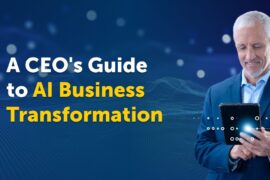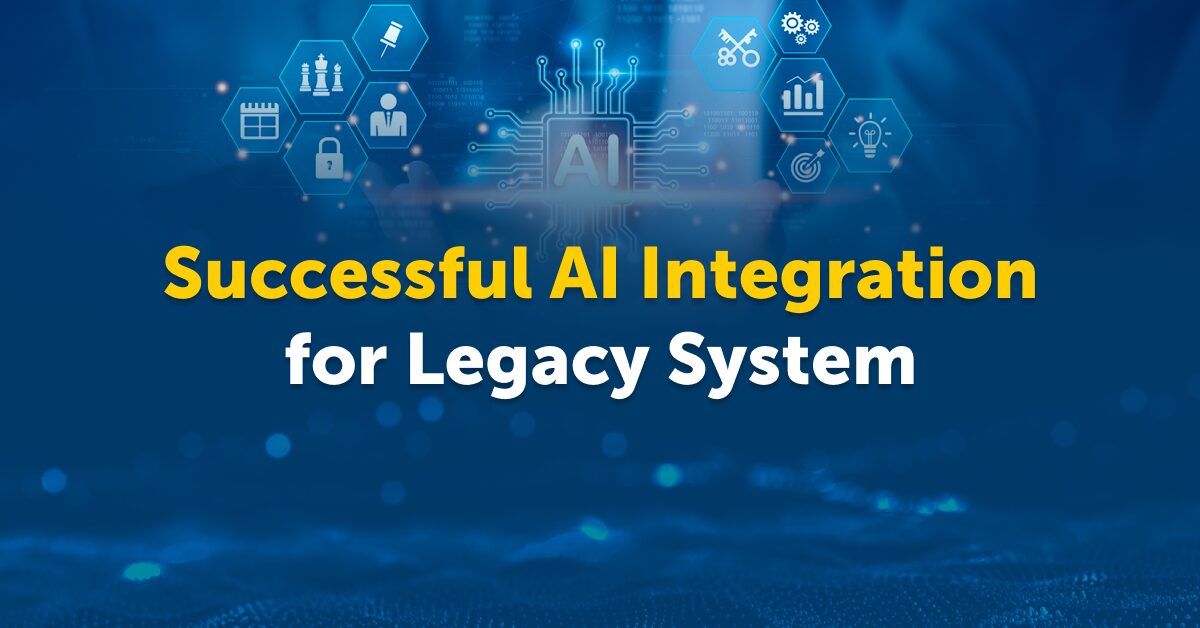A CEO’s Guide to AI Business Transformation

AI is reshaping industries and business models. As a CEO, the question is not whether AI will impact your organization but how you will harness its power to drive innovation.
AI is promising opportunities to optimize processes, gain actionable insights, and meet evolving customer needs. Companies that embed AI into their digital transformation strategies will thrive. AI adoption at scale requires vision, planning, and strong leadership to align technology with business objectives and yield tangible results.
This blog provides CEOs with compelling insights into AI’s pivotal role in business transformation, offering strategies to leverage AI’s potential, lead effective change, and gain a competitive advantage in today’s digital era.
The future is here – are you ready to shape it?

Understanding AI’s Transformative Potential for Business
As CEO, you recognize artificial intelligence’s potential to transform your business and gain a competitive advantage. AI technologies such as machine learning and natural language processing enable systems to learn, adapt, and perform human-like tasks, analyzing huge amounts of data to uncover insights and patterns at a scale and speed humanly impossible.
Harnessing AI’s potential requires understanding how it can enhance and optimize key business functions. In operations, AI increases efficiency and productivity through predictive analytics, intelligent automation, and robotics. For customer experience, AI powers personalization, chatbots, and virtual agents to improve satisfaction and loyalty. AI uncovers opportunities for growth, fuels creativity, and accelerates research and development.
Click here to explore the how Fusemachines transforms businesses with its expert AI solutions. To schedule a complimentary consultation today, click here.
Developing an AI Strategy Aligned With Company Goals
To leverage AI’s potential, CEOs must develop a comprehensive strategy aligned with core business goals. Consider the following steps:
Build an AI-centric culture
Establish an organizational mindset that embraces AI innovation. Communicate a clear vision connecting AI adoption to key performance indicators. Provide opportunities for employees to strengthen AI fluency through training and mentorship programs. Foster a culture where teams can experiment with AI technologies to solve business challenges.
Identify high-impact opportunities
Conduct an analysis of business processes to determine where AI integration would drive the greatest impact. Look for time-consuming, repetitive tasks that could benefit from automation or insights that could enhance strategic decision making. Focus AI efforts on challenges that directly influence customer experience, revenue growth, productivity, and risk mitigation.
Define key priorities and outcomes
Translate identified opportunities into concrete AI initiatives, each with a distinct objective and success metrics. Allocating necessary resources is equally important. Be transparent in communicating priorities to stakeholders. Measure outcomes against predetermined key performance indicators to evaluate progress and make necessary course corrections.
Choose the right AI tools and partners
Select AI solutions that address key priorities and integrate with existing infrastructure. Evaluate technology partners based on industry expertise, tools and services offered, implementation support, and customer references. Negotiate contracts that maximize flexibility as AI needs mature. Consider a phased approach, starting with a pilot program before full-scale deployment. Partnering with Fusemachines brings AI expertise, customized solutions, operational efficiency, and innovation to future-proof your organization.
Continually optimize and innovate
Use data and insights gained from initial AI deployments to optimize tools and processes on an ongoing basis. Encourage teams to explore enhancements and new applications of AI that drive innovation. Stay abreast of advancements in AI to identify new opportunities as they emerge. Make AI optimization and innovation a habit to future-proof your organization.
Key Considerations for Successful AI Adoption
Develop a Strategic AI Vision
Work with other executives to determine how AI can support key business goals and priorities. Focus on high-impact areas and quick wins to build momentum, but also consider long-term AI needs. Create a multi-year AI roadmap to guide investments and progress measurement. Communicate the vision clearly to gain buy-in across the organization.
Build AI Expertise
Hiring or training staff with AI skills is crucial. Data scientists, machine learning engineers, and translators who understand both business functions and AI techniques are in high demand. Consider hiring outside experts to help upskill internal teams. Partnerships with tech companies like Fusemachines can also help access AI talent.
Click here to explore the how Fusemachines transforms businesses with its expert AI solutions.
Choose the Right Technology
With many AI solutions available, selecting tools that integrate well with existing systems and match your needs is important. Consider cloud platforms that provide access to data storage, processing power, and a range of AI services. Start with a pilot project to evaluate options before large-scale implementation. Continually reassess as new technologies emerge to take advantage of the latest capabilities.
Facilitate Change Management
Introducing AI will impact your organization and workforce. Develop plans to address concerns about job security and new ways of working. Provide training to help employees gain AI skills and understand how their roles may evolve. Foster a learning culture where collaboration with AI systems is second nature. Celebrate successes and milestones to maintain enthusiasm for continued progress.
Driving Innovation and Competitive Advantage With AI
To leverage AI for innovation and gain a competitive advantage, CEOs must take a strategic, measured approach. When implemented effectively, AI is a tool that can enhance business processes and uncover opportunities for growth. However, AI adoption requires substantial investment and commitment to succeed. CEOs should focus on areas with high-potential, high-impact areas aligned with key business goals to drive ROI.
Identify Key Performance Indicators
Work with your team to determine 2-3 KPIs critical to business success over the next 3-5 years. Next, evaluate how AI could optimize or reinvent processes to improve those metrics. For example, if customer retention is a priority, explore how AI could enhance personalization, recommendations, and customer service. If operational efficiency is key, analyze how AI might automate repetitive tasks, streamline workflows, and reduce waste. Choosing KPIs guides AI investments toward maximum strategic value.
Start with a Pilot Project
Launch a small pilot project, such as an AI-powered chatbot on your website or an automated workflow for a team. Pilot projects minimize risk while providing an opportunity to gain experience. CEOs can then evaluate results, make refinements, and determine whether to expand the pilot’s scope or resources. Starting small also helps build internal support for AI through visible wins. Employees will become advocates as they see AI enhancing their work.
Establish an AI-Ready Culture
For AI to thrive, organizations need a culture that embraces change and values lifelong learning. CEOs should encourage curiosity about AI’s possibilities and a willingness to experiment. They must also support reskilling and upskilling to prepare employees for AI’s impact on jobs and roles. Building an AI-ready culture will drive innovation as teams gain the knowledge and mindset to ideate new AI applications. It also ensures the workforce is poised to work with AI, not be replaced by it.
Click here to explore the how Fusemachines transforms businesses with its expert AI solutions.
Measuring and Maximizing ROI From AI Initiatives
To maximize the return on investment (ROI) from artificial intelligence (AI) initiatives, CEOs must establish key performance indicators (KPIs) and metrics to assess impact and value properly. Measuring ROI ensures that AI projects align with business goals and drive meaningful results.
Define Success Metrics Upfront
Before launching an AI project, determine how success will be measured. Consider both quantitative metrics such as increased revenue, cost savings, or improved efficiency as well as qualitative metrics such as improved customer satisfaction or employee experience. Metrics should directly correlate with strategic priorities and key business outcomes.
Monitor and Track Progress
Once an AI system is deployed, monitor how it performs relative to predetermined metrics. Track progress through reports that capture data on cost, productivity, revenue gains, or other relevant factors. Make adjustments as needed to optimize the AI system and maximize the potential benefits.
Benchmark Against Industry Standards
Compare the impact of your AI initiatives against industry benchmarks to determine if you’re achieving a competitive advantage. Consider factors such as adoption rates of similar technologies in your industry, projected cost savings or revenue gains, and overall ROI. If below average, reevaluate your AI strategy to gain greater benefits.
Review and Revise
Regularly review the progress and performance of all AI projects to ensure maximum value. As business goals evolve, KPIs and success metrics may need to be revised. Some AI systems may require retraining or updating to improve functionality or outcomes. Be willing to replace underperforming AI projects if they cannot be optimized to meet strategic objectives. With frequent oversight and refinement, AI can become a pivotal driver of business transformation and competitive edge.
Bottom Line
AI is already reshaping industries and business models. As CEO, you must recognize AI’s significant and growing impact and then determine how to channel it to benefit your organization. With a thoughtful, strategic approach to AI adoption, you will gain insights, enhance operations, boost productivity, and achieve goals.
By taking an active leadership role in your AI journey, staying up-to-date with trends, and focusing on business needs, you can successfully transform your company through AI in a way that aligns with your core values and strategy. The future is here, and AI will determine who leads and who follows.
Click here to explore the how Fusemachines transforms businesses with its expert AI solutions. To schedule a complimentary consultation today, click here.


